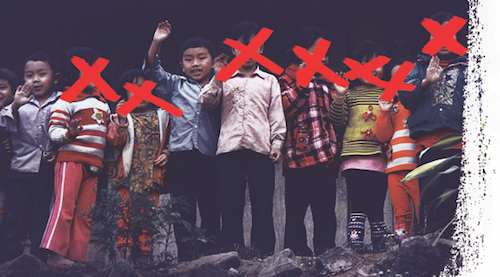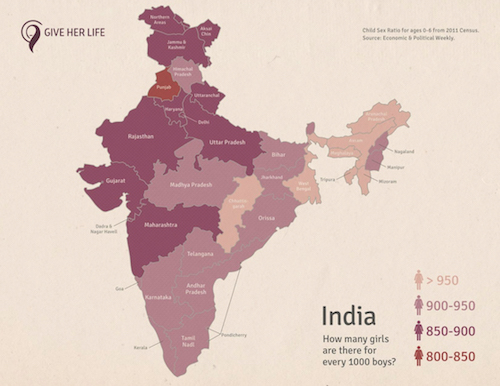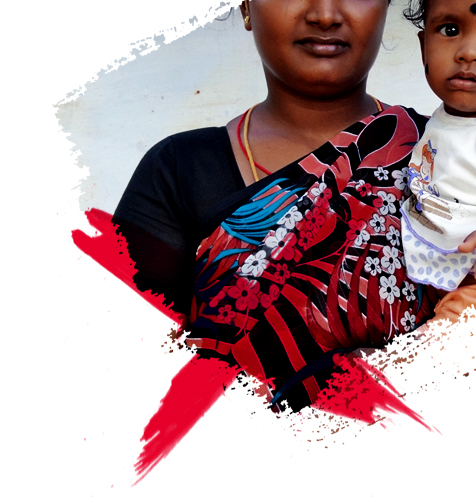Where did all the girls go?
Gendercide and What the Good News Has to Say About It

Around the world, families face great pressure to have a son. Sons mean honor and prosperity; daughters are a financial and social liability. Desperate families respond with desperate measures and try to “select” for a son by killing or aborting daughters. Every year millions of daughters are strangled, suffocated, drowned, lethally neglected, or aborted simply because her family wanted a boy and not a girl. This is called gendercide.
Because of gendercide, girls are disappearing at an alarming rate. In 2005, demographer Christophe Guilmoto estimated that Asia was currently missing 163 million women and girls from their population due to gendercide.[1] Gendercide has continued since then, and kept growing. The United Nations puts their estimate at closer to 200 million women.[2] In a single generation, more women have gone “missing” from Asia due to gendercide than all the girls and women alive in the United States.
When I first encountered these issues, my heart broke. I grieved for the lives lost. I grieved for the mothers and fathers who faced such immense pressure that they felt compelled to discard their child. I grieved for the stories I heard, for the mother who declared that for her daughter it was “better for her to die” than to live in the situations of abuse and hardship her mother had faced, for the mother that strangled and buried seven daughters.
Gendercide is rooted in a belief that a girl offers little to her family in terms of social or financial benefit, but a boy offers much more. I grieved at the thought of measuring the worth of a human life in financial and social status.

But I believe the gospel can indeed be good news to families and communities facing gendercide. This isn’t about asking people to pray a prayer and “convert.” Nor is it just about rescuing unwanted girls. It’s about a transformation of individuals and families to embrace their kingdom identity as people loved by God and called to love others. For me, the understanding of good news has come to rest heavily on the idea that humans are made in the image of God. (See “The Image of God: A Dignifying Invitation.”) Each person has value because he or she is created, known and loved by God.
The good news is that you matter. You are made in the image of God, which means you have worth and dignity that is sacred and eternal. Your life is not disposable. Your value is not conditional on your status, your wealth or your gender. It cannot be tarnished.
The good news is that you can know God. God is not a faraway deity who has no interest in you. He knows you and wants you to know Him. This is a radically different understanding of God from religious traditions where the gods pursue their own ends and have little concern for humans. But God cares so much about being known that He sent Jesus to show us who God is and how much He cares about us.
The good news is that others also have worth and dignity. When we come to understand our own place before God, we can extend the same grace to others. This transforms the way we treat one another, including our own families and children.
The good news is that your salvation is not your own work. God made the first move towards us. This is not a matter of struggling to please a flippant god or trying to be good enough. God declared that we are created, known and loved. He loved us first. This is why we have the gall to hope that God will enter into our brokenness to redeem us.
We can believe with confidence that God cares for these girls and their families, and that it is within His power to shine His light into the darkness that is gendercide. So let’s dive in and get a better understanding of what’s happening. Here are some of the basics.
How does this happen?
These girls have been eliminated primarily through sex-selective abortion specifically targeted at terminating a female fetus in hopes of later conceiving a male. Families with less access to ultrasound and abortion may also kill a newborn daughter, or simply withhold life essentials such as food and medical care. In both India and China, there are laws against finding out the sex of a fetus, aborting because of the fetus’s sex, and killing a child. However, the practices continue with little resistance. A girl is killed or aborted every 16 seconds, simply because she is a girl.[3]
How do we know how many women are “missing” due to gendercide?
The prevalence of gendercide is measured by the male to female sex ratio. A sex ratio reports how many males there are compared to how many females in a certain age group (often ages 0-6) in a certain area. If there is no gendercide, the natural number of males and females would be about even. The presence of many more boys than girls indicates the practice of gendercide.

Some areas report dramatically skewed sex ratios. For example, the sex ratio of the 0-6 age range in the Indian state of Punjab is 846 girls per 1,000 boys.[4] Another example, China’s sex ratio for children 0-5 years old stood at 810 girls for every 1,000 boys in 2005, so we know that many of those girls have been eliminated from the population.[5]
Although the sex ratio is the primary measure of gendercide, other types of evidence can also contribute to our understanding. For example, a study in Delhi found “that out of 8,000 cases, 7,999 aborted fetuses were female; another Bombay study indicated that of 1,000 cases, 97 percent were female.”[6]
Where is this happening?
India and China account for the majority of the missing women (See “A Case Study from India”). Vietnam, Georgia, Armenia, Albania and Azerbaijan also have dramatically skewed child sex ratios.[7] It is important to keep in mind, however, that the sex ratio can vary greatly depending on the area of the country. Although gendercide is not practiced exclusively by one particular religious block, the majority of communities that practice gendercide are among unreached people groups.
Why is it happening?
Families desire sons for a multitude of cultural, religious, and economic reasons and will go to great lengths to ensure that their offspring are male. Gendercide thrives in patriarchal societies that have traditionally valued men over women. Sons bring honor to a family while girls bring shame and economic burden. Sons carry on the family lineage and are able to inherit any wealth or business the family might own. Among Hindus, it is the eldest son that lights the funeral pyre at his father’s funeral so that his soul can move into the afterlife. In India, daughters are seen as a financial burden due to the cultural tradition of paying a dowry to the groom’s family at the marriage of a daughter. Although exchanging dowry is technically illegal, it continues in a modernized version and can be up to ten times a family’s annual income.

Moreover, spending money on a daughter’s education is seen as investment with no return as she will most likely marry and then she and her children will belong to another family. It is also likely upon marriage that a woman will no longer work, even if she previously held a job. Both Indian and Chinese parents worry that without a son, they will have no one to care for them in their old age. Therefore a son is financial security for aging parents. Sons are an asset, daughters a liability.
There is a widespread belief that gendercide is naturally decreasing as education and modernization spread, but the evidence shows otherwise. Son preference is as old as time, but three developments in recent decades have exacerbated gendercide. The first is technological expansion, which has made ultrasound tests and abortions cheap and accessible. The second is a demographic shift to smaller family sizes, making families more likely to take measures to ensure that their first or second child is a son. The third development is government policy that limits family size and encourages abortion as a tool for family planning. (See “Tackling Gendercide and the Two-Child Policy.") Although it is illegal in China and India to find out the sex of a fetus or get a sex-selective abortion, these regulations are rarely enforced. (See “Gendercide in India: What’s making a difference?” for more on how governments and NGOs can decrease gendercide.)
What are the consequences?
The consequences of a population missing millions of women and girls are large and far-reaching. Due to the lack of females in certain communities, many men cannot find eligible women to marry. These men are known as bare branches.[8] It is estimated by the year 2020 that approximately 15% of young adult men in China and India will be bare branches. To meet the demand, women are trafficked to become wives of men who cannot find a bride locally. Men are paying large sums to obtain a wife. As age appropriate women become scarce, the market turns to child brides to fill the gap. Essentially, marriage becomes commoditized as women are bought and sold as a supply and demand mentality overtakes entire populations. The elimination and abuse of women has terrible consequences not only for women, but also for men, families, and communities (See “The Ripple Effect”).
Conclusion
I dream of a world where women are given a chance to exist, their innate value is respected, and they are able to fully contribute to their families, communities, and world. I believe this world would be better for all of us, and that the Church has something unique to offer in bringing it about. I lead an organization[9] whose vision is for the restoration of families and communities where girls can flourish and gendercide is eradicated.[10] But this is only possible because we believe that God gave intrinsic worth to each life, regardless of gender.

Never before have I been so compelled by the understanding that humans bear the image of God. This is what gives each of us worth and dignity. This is why we treat others with worth and dignity. And this is why we have the courage to hope that the God of the universe will stoop down low to whisper His love in our ear. But how heart breaking it would be to live without knowing that you have intrinsic value! That value will not tarnish or fade. It is not dependent on social status or finances or being born female. If you've never heard this before, it is indeed good news.
[1] Guilmoto, Christophe. 2012. Sex Imbalances at Birth: Current Trends, Consequences and Policy Implications. Edited by UNFPA Thailand. Bangkok, Thailand: UNFPA Asia and the Pacific Regional Office.
[2] A. Diamantopoulou, 4 May 2000. Speech at the conference Violence against Women: Zero Tolerance, http://www.eurowrc.org/13.institutions/1.ec/ec-en/05.ec_en.htm found. via: Vlachova, Marie and Biason, Lea, Eds. (2004). Women in an Insecure World: Violence Against Women – Facts, Figures and Analysis. Geneva Centre for the Democratic Control of Armed Forces.http://www.unicef.org/emerg/files/women_insecure_world.pdf.
[3] Hudson, Valerie M. and den Boer, Andrea M. 2005. Bare Branches: The Security Implications of Asia’s Surplus Male Population. MIT Press. Page 112-113.
[4] 2011 India Census. Gender Composition of the Population. Available from http://www censu.sindia. gov. in/2011-prov-results/data_files/india/Final_PPT_2011_chapter5. pdf.
[5] Zhen, Guo, Monica Das Gupta, and Li Shuzhuo. 2013. "Missing Girls" in China and India: Trends and Policy Impacts. Maryland Population Research Center.
[6] Hudson, Valerie M. and den Boer, Andrea M. 2005. Bare Branches: The Security Implications of Asia’s Surplus Male Population. MIT Press. Page 111.
[7] CIA World Fact Book 2013. Available from https://www cia. .gov/library/publications/the-world-factbook/.
[8] Hudson, Valerie M. and den Boer, Andrea M. 2004. ‘Bare Branches’ and Danger in Asia. Washington Post. http://www.washingtonpost.com/wp-dyn/articles/A24761-2004Jul2.html
.[9] Give Her Life http://www.giveherlife.org
.[10] Give Her Life’s core motivation is to follow Jesus’ example of servanthood and love for all people, families, and nations. We embrace opportunities to serve and partner with people regardless of religion.








comments